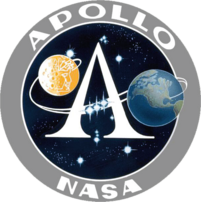Apollo 12
| Apollo 12 | |||||
Mission insignia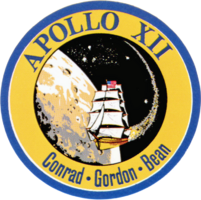 |
|||||
| Mission statistics | |||||
|---|---|---|---|---|---|
| Mission name | Apollo 12 | ||||
| Command Module | CM-108 callsign Yankee Clipper mass 28,838 kg |
||||
| Service Module | SM-108 | ||||
| Lunar Module | LM-6 callsign Intrepid mass 15,235 kg |
||||
| Crew size | 3 | ||||
| Booster | Saturn V SA-507 | ||||
| Launch pad | LC 39A Kennedy Space Center Florida, USA |
||||
| Launch date | November 14, 1969 16:22:00 UTC |
||||
| Lunar landing November 19, 1969 06:54:35 UTC Oceanus Procellarum/Mare Cognitium (Ocean of Storms/Known Sea) 3° 0' 44.60" S 23° 25' 17.65" W |
|||||
| Lunar EVA duration | First 3 h 56 m 03 s Second 3 h 49 m 15 s Total 7 h 45 m 18 s |
||||
| Lunar surface time | 31 h 31 m 11.6 s | ||||
| Lunar sample mass | 34.35 kg (75.729 lb) | ||||
| Number of lunar orbits | 45 | ||||
| Total CSM time in lunar orbit | 88 h 58 m 11.52 s | ||||
| Landing | November 24, 1969 20:58:24 UTC |
||||
| Mission duration | 10 d 4 h 36 m 24 s | ||||
| Apogee | 189.8 km | ||||
| Perigee | 185 km | ||||
| Apolune | 257.1 km | ||||
| Perilune | 115.9 km | ||||
| Orbital period | 88.16 m | ||||
| Orbital inclination | 32.54° | ||||
Crew photo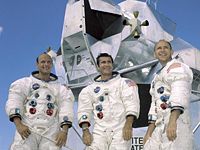 Left to right: Conrad, Gordon, Bean |
|||||
| Related missions | |||||
|
|||||
Apollo 12 was the sixth manned mission in the Apollo program and the second to land on the Moon.
Contents[hide] |
Crew
Number in parentheses indicates number of spaceflights by each individual prior to and including this mission.
- Charles Conrad, Jr (3) - commander
- Richard F. Gordon, Jr. (2) - command module pilot
- Alan L. Bean (1) - lunar module pilot
Backup crew
- David R. Scott - commander
- Alfred M. Worden - command module pilot
- James B. Irwin - lunar module pilot
(The backup crew would later fly on Apollo 15.)
Support crew
- Gerald P. Carr
- Edward G. Gibson
- Paul J. Weitz
Flight directors
- Gerry Griffin, Gold team
- Pete Frank, Orange team
- Cliff Charlesworth, Green team
- Milton Windler, Maroon team
Mission parameters
- Landing Site: W [1]3.01239 S - 23.42157 W] or
3° 0' 44.60" S - 23° 25' 17.65" W
LM — CSM docking
- Undocked: November 19, 1969 – 04:16:02 UTC
- Redocked: November 20, 1969 – 17:58:20 UTC
EVAs
EVA 1 start: November 19, 1969, 11:32:35 UTC
- Conrad — EVA 1
- Stepped onto Moon: 11:44:22 UTC
- LM ingress: 15:27:17 UTC
- Bean — EVA 1
- Stepped onto Moon: 12:13:50 UTC
- LM ingress: 15:14:18 UTC
EVA 1 end: November 19, 15:28:38 UTC
- Duration: 3 hours, 56 minutes, 03 seconds
EVA 2 start: November 20, 1969, 03:54:45 UTC
- Conrad — EVA 2
- Stepped onto Moon: 03:59:00 UTC
- LM ingress: 07:42:00 UTC
- Bean — EVA 2
- Stepped onto Moon: 04:06:00 UTC
- LM ingress: 07:30:00 UTC
EVA 2 end: November 20, 07:44:00 UTC
- Duration: 3 hours, 49 minutes, 15 seconds
Quotations
Whoopie! Man, that may have been a small one for Neil, but that's a long one for me.[2] — Pete Conrad (somewhat shorter in stature than Armstrong) as he stepped onto the lunar surface for the first time. Conrad had actually come up with the quote some time before the mission, to prove to reporter Oriana Fallaci that Neil Armstrong had not been told by NASA what to say as he stepped onto the Moon. He had bet Fallaci $500 that he would say the quote, but later claimed he was never able to collect the money.
Mission highlights

Alan Bean descends from the LM. (NASA)
|
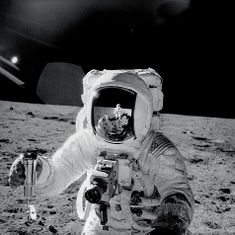
Alan Bean pictured by Pete Conrad (reflected in Bean's helmet) (NASA)
|
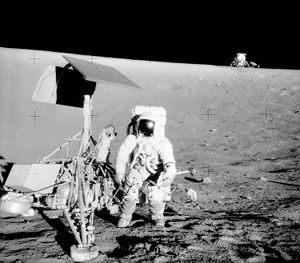
Bean, Surveyor 3 and the LM Intrepid (NASA)
|
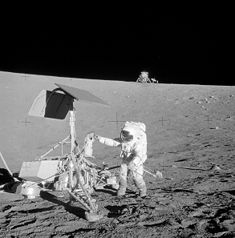
Conrad jiggles the Surveyor III craft. (NASA)
|
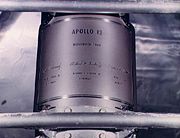
Photograph of the plaque attached to the Apollo 12 LM
|
Apollo 12 launched on schedule, during a rainstorm. 36.5 seconds after lift-off from Kennedy Space Center, the Saturn V rocket body was hit by a bolt of lightning. The CM's instruments momentarily went off-line and Mission Control lost the telemetry feeds from the spacecraft for several seconds. When ground control regained telemetry lock with the spacecraft, the feeds were garbled and reported incomplete and possibly inaccurate information. EECOM John Aaron thought that the garbled telemetry might be caused by a malfunction in the launch vehicle's Signal Conditioning Equipment (SCE), since the SCE converted raw instrument data into forms usable by spacecraft instrument displays and ground telemetry equipment, and it would have automatically gone off-line in response to the kind of disruption to the spacecraft's electrical systems that a lightning strike would cause.[3]
With this in mind, Aaron suggested the crew "Try SCE to aux" – thereby forcing the backup SCE on-line. The command was a relatively obscure one and neither the Flight Director, nor CAPCOM, nor Mission Commander Conrad could immediately recall how to implement it; however, lunar module pilot Alan Bean remembered that the SCE switch was on his panel because of a training incident a year prior to launch where just such a failure had been simulated. Aaron's quick thinking and Bean's memory were able to salvage what otherwise would have been an aborted mission (at the time of the failure, the flight had just entered abort mode One Bravo). With telemetry restored, the crew proceeded to parking orbit and was able to restore and verify the functionality of their spacecraft before re-igniting the S-IVB third stage for trans-lunar injection.
The S-IVB was originally intended to be put into a solar orbit by venting the remaining propellant. However, an extra long burn of the ullage motors meant that venting the remaining propellant in the tank of the S-IVB did not give the rocket stage enough energy to escape the Earth-Moon system and instead the stage ended up in a semi-stable orbit around the Earth after passing by the Moon in November 18, 1969. It finally entered into solar orbit 1971, but returned to Earth orbit (briefly) 31 years later. It was discovered by amateur astronomer Bill Yeung and he gave it the temporary designation J002E3 before it was determined to be an artificial object.
The Apollo 12 mission landed on an area of the Ocean of Storms that had been visited earlier by several unmanned missions (Luna 5, Surveyor 3, and Ranger 7). The International Astronomical Union, recognizing this, christened this region Mare Cognitium (Known Sea). The landing site would thereafter be listed as Statio Cognitium on lunar maps (Conrad and Bean did not formally name their landing site, interestingly enough, though the intended touchdown point was nicknamed Pete's Parking Lot by Conrad).
The second lunar landing was an exercise in precision targeting, using a Doppler Effect radar technique developed to allow the pinpoint landings needed for future Apollo missions. Most of the descent was automatic, with manual control assumed by Conrad during the final few hundred feet of descent. Unlike Apollo 11 where Neil Armstrong took partial control of the lander and directed it further down range when he noticed that the intended landing site was strewn with boulders, Apollo 12 succeeded, on November 19, in landing within walking distance (less than 200 meters) of the Surveyor 3 probe, which had landed on the Moon in April 1967.
Conrad actually landed Intrepid 580 feet short of Pete's Parking Lot because the planned landing point looked rougher than anticipated during the final approach to touchdown. The planned landing point was a little under 1180 feet from Surveyor 3, a distance that was chosen to eliminate the possibility of lunar dust (being kicked up by Intrepid's descent engine during landing) from covering Surveyor 3. But the actual touchdown point — 600 feet from Surveyor 3 — did cause a thin film of dust to coat the probe, giving it a light tan hue.
To improve the quality of television pictures from the Moon, a color camera was carried on Apollo 12 (unlike the monochrome camera that was used on Apollo 11). Unfortunately, when Bean carried the camera to the place near the lunar module where it was to be set up, he inadvertently pointed it directly into the Sun, destroying the vidicon tube. Television coverage of this mission was thus terminated almost immediately.
Conrad and Bean removed pieces of the Surveyor 3, to be taken back to Earth for analysis. It is claimed that the common bacterium Streptococcus mitis was found to have accidentally contaminated the spacecraft's camera prior to launch and survived dormant in this harsh environment for two and a half years.[4] However, this finding has since been disputed: see the article Reports of Streptococcus mitis on the moon.
Astronauts Conrad and Bean also collected rocks and set up equipment that took measurements of the Moon's seismicity, solar wind flux and magnetic field, and relayed the measurements to Earth. (By accident Bean left several rolls of exposed film on the lunar surface.) Meanwhile Gordon, on board the Yankee Clipper in lunar orbit, took multispectral photographs of the surface.
The lunar plaque attached to the descent stage of Intrepid is unique in that unlike the other lunar plaques, it (a) did not have a depiction of the Earth, and (b) it was textured differently (the other plaques had black lettering on polished stainless steel while the Apollo 12 plaque had the lettering in polished stainless steel while the background was brushed flat).
Intrepid's ascent stage was dropped (per normal procedures) after Conrad and Bean rejoined Gordon in orbit. It impacted the Moon on November 20, 1969 at 3.94 S, 21.20 W. The seismometers the astronauts had left on the lunar surface registered the vibrations for more than an hour.
The crew stayed an extra day in lunar orbit taking photographs, for a total lunar surface stay of thirty-one and a half hours and a total time in lunar orbit of eighty-nine hours.
Yankee Clipper returned to Earth on November 24, 1969, at 20:58 UTC (3:58pm EST, 10:58am HST), approximately 500 miles (800 km) east of American Samoa. During landing, a 16 mm camera dislodged from storage and struck Bean in the forehead, rendering him briefly unconscious. He suffered a mild concussion, and needed six stitches.
The Yankee Clipper is displayed at the Virginia Air and Space Center, Hampton, Virginia. Its recovery ship, the USS Hornet, is now open to the public as a museum in Alameda, California.
The Surveyor 3 camera retrieved by the Apollo 12 astronauts now resides in the Exploring the Planets gallery at the National Air and Space Museum. [5]
Attempted stunts
- Alan Bean smuggled a camera-shutter self-timer device on to the mission with the intent of taking a photograph with himself, Pete Conrad and the Surveyor 3 probe in the frame. As the timer was not part of their standard equipment, such an image would have thrown post-mission photo analysts into confusion over how the photo was taken. However, the self-timer was misplaced during the EVA and the plan was never executed.

- The Apollo 12 backup crew managed to insert into the astronaut's lunar checklist (attached to the wrists of Conrad's and Bean's spacesuits) reduced sized pictures of Playboy centerfolds, surprising Conrad and Bean when they looked through the checklist flip-book during their first EVA.[6] The Lunar Surface Journal website [1] contains a PDF with the photocopies of their cuff checklists showing these photos.[7] The checklists also contains two pages of pre-prepared complex geological terminology at the back, to be used for the confusion of the ground crew.
- The artist Forrest (Frosty) Myers claims to have installed the art piece "Moon Museum" on "a leg of the Intrepid landing module with the help of an unnamed engineer at the Grumman Corporation after attempts to move the project forward through NASA's official channels were unsuccessful."[8]
- In a more sombre moment in an otherwise jovial mission, Bean brought Clifton Williams' pilot wings with him and left them in the lunar dust.
Mission insignia
The Apollo 12 mission patch shows the crew's Navy background. It features a clipper ship arriving at the moon. The ship trails fire and flies the flag of the United States. The mission name APOLLO XII and the crew names are on a wide gold border, with a small blue trim. Blue and gold are traditionally Navy colors. The patch has four stars on it — one each for the three astronauts who flew the mission and one for Clifton Williams. Williams was killed on October 5, 1967, after a mechanical failure caused the controls of his T-38 trainer to stop responding. He trained with Conrad and Gordon as part of the back-up crew for what would be the Apollo 9 mission, and would have been assigned as Lunar Module pilot for Apollo 12.
Capsule location
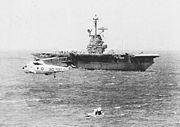
The Apollo 12 Command Module Yankee Clipper is on display at Virginia Air and Space Center, Hampton, Virginia.
The Lunar Module Intrepid impacted the Moon November 20, 1969 at 22:17:17.7 UT (5:17 PM EST) 3.94 S, 21.20 W.
Depiction in fiction
Portions of the Apollo 12 mission are dramatized in the miniseries From the Earth to the Moon episode entitled "That's All There Is". Conrad, Gordon and Bean were portrayed by Paul McCrane, Tom Verica and Dave Foley, respectively. Conrad had been portrayed by a different actor, Peter Scolari, in the first two episodes.
See also
- Extra-vehicular activity
- List of spacewalks
- Splashdown
- List of artificial objects on the Moon
- Google Moon
References
Notes
Bibliography
- Analysis of Apollo 12 Lightning Incident, (PDF) February 1970
- Analysis of Surveyor 3 material and photographs returned by Apollo 12 (PDF) 1972
- Apollo 12 Characteristics — SP-4012 NASA Historical Data Book
- Apollo 12 Mission Report (PDF) March 1970
- Chaikin, Andrew. A Man on the Moon: The Voyages of the Apollo Astronauts. New York: Penguin Books. 1995. ISBN 978-0140241464.
- Examination of Surveyor 3 surface sampler scoop returned by Apollo 12 mission (PDF) 1971
- Lattimer, Dick. All We Did was Fly to the Moon. Alachua, FL: Whispering Eagle Press, 1985. ISBN 0-9611228-0-3.
External links
- Apollo Lunar Surface QTVR Panoramas
- Image of mission patch
- Map of surface activities for Apollo 12
- Apollo 12 entry in Encyclopedia Astronautica
- NASA NSSDC Master Catalog
- APOLLO BY THE NUMBERS: A Statistical Reference by Richard W. Orloff (NASA)
- The Apollo Spacecraft: A Chronology
- Apollo Program Summary Report
- Apollo 12 Science Experiments
|
|||||||
